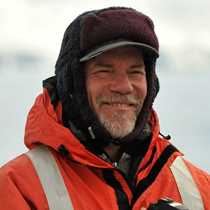Inverewe & Ullapool
Western Scotland is a place of stark contrasts, rich with the possibilities of exploration and discovery. The coastline itself is a maze of land and sea, deeply indented by long sea lochs and dotted with low islands and skerries. Rising from the dark waters, the steep hills roll back into the highlands. Green with soft spring grass, they are a happy home for sheep and bouncing lambs. But one never has to look far to find jagged outcrops of schist and gneiss, the ancient bones of the land weathering through the thin skin of life. The hills and headlands divide the country, blocking travel and restricting view so that new vistas are revealed around each turn in the road and another always waits just beyond the next bend.
The world beneath the surface of Scottish seas is another realm of contrasts and surprises. Deep in the shadows of the dark green waters, below the jagged gray rocks of the shore, who would expect to find carpets of tiny pink anemones, delicate orange corals and fairyland forests of golden kelp, undulating in the surge of the waves? The seas around the British Isles are justly famous for their beauty and the rich diversity of fish, crabs, sea stars and other animals inhabiting them. Just during the last few days in the western isles of Scotland we have explored many different marine environments and a remarkable variety of underwater landscapes. There are caves and ledges sheltering lobsters and curious grey seals, rocky bottoms strewn with boulders as big as houses and festooned with corals and sponges, sandy bottoms where flatfish and sea stars rest.
If one habitat really characterizes the seas of this region it is the kelp forest. Though the species here only grow to about five or six feet tall, it is just as much a forest as the towering ones in California and Chile. The canopy of leaf-like fronds forms a dense thatch and catches the light that nourishes the photosynthetic kelp organisms. In the shady understory below, the stipes stand straight, covered with red algae like moss on the trunks of trees. Further down, on the bottom, hermit crabs, sea squirts and hydroids form a thick turf and provide food for the many species of fish that make the kelp forest their home.
Above and below the waterline, Scotland and the British Isles are full of unexpected discoveries and juxtapositions, a place where exploration is always exciting and often well rewarded.
Western Scotland is a place of stark contrasts, rich with the possibilities of exploration and discovery. The coastline itself is a maze of land and sea, deeply indented by long sea lochs and dotted with low islands and skerries. Rising from the dark waters, the steep hills roll back into the highlands. Green with soft spring grass, they are a happy home for sheep and bouncing lambs. But one never has to look far to find jagged outcrops of schist and gneiss, the ancient bones of the land weathering through the thin skin of life. The hills and headlands divide the country, blocking travel and restricting view so that new vistas are revealed around each turn in the road and another always waits just beyond the next bend.
The world beneath the surface of Scottish seas is another realm of contrasts and surprises. Deep in the shadows of the dark green waters, below the jagged gray rocks of the shore, who would expect to find carpets of tiny pink anemones, delicate orange corals and fairyland forests of golden kelp, undulating in the surge of the waves? The seas around the British Isles are justly famous for their beauty and the rich diversity of fish, crabs, sea stars and other animals inhabiting them. Just during the last few days in the western isles of Scotland we have explored many different marine environments and a remarkable variety of underwater landscapes. There are caves and ledges sheltering lobsters and curious grey seals, rocky bottoms strewn with boulders as big as houses and festooned with corals and sponges, sandy bottoms where flatfish and sea stars rest.
If one habitat really characterizes the seas of this region it is the kelp forest. Though the species here only grow to about five or six feet tall, it is just as much a forest as the towering ones in California and Chile. The canopy of leaf-like fronds forms a dense thatch and catches the light that nourishes the photosynthetic kelp organisms. In the shady understory below, the stipes stand straight, covered with red algae like moss on the trunks of trees. Further down, on the bottom, hermit crabs, sea squirts and hydroids form a thick turf and provide food for the many species of fish that make the kelp forest their home.
Above and below the waterline, Scotland and the British Isles are full of unexpected discoveries and juxtapositions, a place where exploration is always exciting and often well rewarded.




